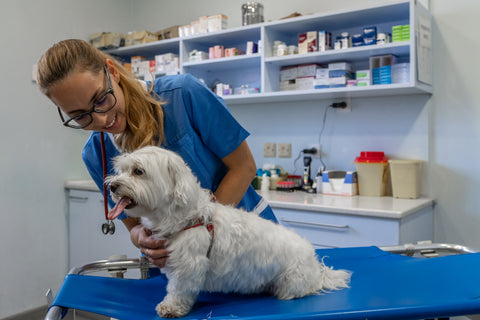A basic understanding of canine health problems can help ensure you provide the best possible preventative care to your furry friend, regardless of their size or age. However, small dogs deal with unique health challenges that are far less common in larger breeds. Learning about the warning signs of these possible canine health problems can keep your furry friend healthy and safe.
Tracheal Collapse
A dog's trachea (the windpipe) is a flexible tube surrounded by C-shaped cartilage rings. These rings maintain the trachea's openness, allowing air to flow in and out of the lungs. The tracheal collapse is a respiratory dog health problem where these cartilage rings weaken and cave in. As a result, your dog may find it difficult to breathe as these rings lose structure.
Some symptoms to look out for include:
- Harsh coughing
- Fainting
- Wheezing
- Gagging or vomiting
- Episodes of cyanosis (turning blue)
Causes and Risk Factors
The cause of tracheal collapse is often unknown, though it might stem from a congenital disorder. A congenital disorder occurs when dogs are born with a condition or genetic mutation.
Environmental factors and concurrent diseases can exacerbate tracheal collapse symptoms.
Certain risk factors contributing to this include:
- Obesity
- Airway Irritants
- Respiratory Infections
- History of Anesthesia
- Heart Enlargement

Diagnosis and Treatment Options
Vets use special X-rays to find and diagnose the suspected tracheal collapse.
After diagnosing, vets may prescribe medication to ease coughing and inflammation. Some of these medications include:
- Cough Suppressants
- Antibiotics
- Anti-inflammatories
- Sedatives
Tips for Managing Tracheal Collapse in Small Dogs
Dog medical issues like a tracheal collapse can be distressing. Promoting weight loss is essential in managing tracheal collapse to alleviate breathing difficulties, as chest fat can worsen the condition. Opting for gentle, leisurely walks and using harnesses is necessary to mitigate tracheal pressure during outings.
Patellar Luxation
Patellar luxation is one of the most common health problems of small dog breeds involving bones. It happens when the kneecap dislocates, moving out of its normal position within the knee groove while the leg is bent. This condition is painful and potentially debilitating, affecting the dog's hind legs.
Patellar luxation is typically inherited. It causes alignment issues during skeletal growth and can appear as early as eight weeks old.
Common Breeds Prone to Patellar Luxation
Small dog breeds are most susceptible to patellar luxation. Boston Terriers, Yorkshire Terriers, Maltese, Bichon Frise, Chihuahuas, Pomeranians, and Toy Poodles are more frequently affected than other breeds.

Symptoms and Diagnosis Methods
Dogs with this condition might display minimal or no signs, but typically, they'll momentarily lift or "skip" their affected limb and then shake it before resuming use. Some other symptoms include:
- Difficulty jumping
- Hind leg weakness or hobbling
- Reluctance to run or exercise
- Bow-legged or knock-kneed stance
- Sudden yelps of pain during activity
Suspected canine health problems, like patellar luxation, require prompt evaluation to alleviate your furry friend's pain. Taking your dog to the veterinarian is essential as this condition will not improve and can worsen over time.
Treatment Options: Surgery and Physical Therapy
Treating patellar luxation varies based on severity and a dog's specific signs. Mild cases without signs often need no treatment.
Surgery can benefit dogs with severe pain from cartilage damage and noticeable lameness. Physical therapy can help minimize muscle loss and speed up the return to function for some dogs.
Reducing the Risk of Patellar Luxation
You can lower the likelihood of a luxating patella. Some preventative measures include:
- Maintaining a healthy weight
- Engaging your dog in low-impact exercises to strengthen joints
- Discussing joint supplements with your vet
- Paying attention to early signs of patellar luxation
- Scheduling routine vet check-ups for timely intervention
Mitral Valve Disease
Mitral valve disease, a common small dog disease, involves the deterioration or abnormal function of the mitral valve. This condition causes blood to leak back into the heart chamber, increasing potential heart failure over time.

Symptoms and Progression of the Disease
The health problems with dogs that have mitral valve disease can be moderate or severe based on its progression.
Common symptoms of mitral valve disease include:
- Lethargy
- Mild coughing
- Heart murmurs
The progression of the disease may result in:
- Severe coughing
- Difficulty breathing
- Increased respiratory rate
- Intolerance to exercise
- Congestive heart failure
The development of congestive heart failure creates severe breathing difficulties and fluid buildup. Heart failure requires immediate veterinarian care for your companion's stabilization.
Diagnostic Tests and Monitoring
When diagnosing heart valve disease in dogs, several tests are essential to assess different aspects of heart function and detect underlying conditions. Some diagnostic tests include:
- Physical examinations
- Chest radiography (X-rays)
- Blood and urine tests
- Electrocardiograms
- Ultrasound Examinations
Treatment Options: Medication and Lifestyle changes
Mitral valve disease in dogs is treated with various prescribed medications and lifestyle changes to restore heart function and manage symptoms.
Besides prescribed medication, there are lifestyle changes that can mediate or prevent this disease. Some include:
- Low-salt Diet
- Regular Exercise
- Weight Management
- Stress Reduction
Dental Disease
Just like humans, dogs are also prone to dental diseases and conditions. Pets might not overtly express pain, but subtle signs like avoiding hard chewing, preferring softer foods, or pawing at their mouth can signal discomfort. All health problems with dogs' teeth should be taken seriously to ensure your dog eats.
Common Dental Problems in Small Dogs and Treatments
Dental health issues in dogs are more common with small dogs. In small dog breeds, teeth are likely overcrowded due to the challenge of fitting numerous teeth into a small mouth.

Overcrowding can lead to misplaced or extra teeth. Other common dental health problems with dogs include:
- Periodontal Disease: Affects tissues around teeth, starts as gingivitis, and progresses to bone loss around the teeth. Treatment can include proper dental care for mild cases and tooth extraction for severe cases.
- Gingivitis: Gingivitis is inflamed gums and the early stage of gum disease. Brushing your dog's teeth daily and reverse gingivitis.
- Plaque Buildup: Plaque, a mix of bacteria and saliva, forms tartar when it builds up on the dog's teeth. Getting your companion a dental cleaning can decrease plaque buildup.
- Tooth Fractures: Tooth breakage leads to exposed pulp, causing pain. Dentists treat fractures by removing the tooth.
- Malocclusions: Abnormal teeth in the jaw causing pain. Malocclusions require treatment to correct the tooth position or extract the tooth.
Preventive Measures for Dental Health Problems with Dogs
Dental health issues in dogs are preventable. Some of the preventative measures for these canine health problems include:
- Daily teeth brushing
- Appropriate diet
- Teeth-friendly treats
- Regular veterinary visits
- Dental treatments
Obesity
Obesity is the accumulation of excess body fat, increasing body weight. Overweight canines typically weigh 10-20% more than their optimal body weight [1].
Overeating, a lack of physical activity, genetic mutations, hormone imbalances, or medical disorders can cause this condition.
Risks of Obesity
Obesity poses significant health issues in dogs, actively lowering their lifespan and raising their risk of developing various illnesses. Excess fat tissue can lead to illnesses such as cancer, heart disease, and diabetes mellitus.
In addition, obesity negatively affects dogs' joints by applying excessive pressure to them. Obesity can cause disorders such as osteoarthritis and joint degeneration.
Dietary Recommendations for Managing Weight
To manage weight in dogs, consider specific changes such as using veterinary-formulated meals designed for weight loss. It is critical to choose lower-calorie density diets while keeping the ideal nutrient balance.

Exercise Tips to Promote Weight Loss
Regular exercise is essential for weight loss in dogs. Here are some exercise techniques to help your dog lose weight:
- Engage in brisk walks or jogs to promote calorie burning.
- Incorporate interactive play sessions such as fetch or tug-of-war.
- Swimming, a low-impact activity, might help your companion lose weight without putting strain on its joints.
Hypoglycemia
Hypoglycemia is a low circulating glucose level in the bloodstream. It often results from inadequate food intake, excessive exercise, or underlying health issues. This condition leads to symptoms like weakness, tremors, and seizures. Immediate attention is crucial to managing this canine health problem.
Emergency Measures to Stabilize Blood Sugar Levels
Getting sugar, like honey or syrup, into your dog's mouth can stabilize glucose levels during a hypoglycemic episode. In severe cases or if the dog is unconscious, contact a veterinarian immediately to balance blood sugar levels.
Long-Term Management: Preventing Hypoglycemic Episodes
Long-term management of hypoglycemia in dogs requires preventive measures to ensure stable blood sugar levels.
Some active measures to prevent hypoglycemia episodes include:
- Regular feeding schedule
- A Balanced diet
- Monitoring exercise
- Veterinary check-ups
- Prescribed Medication
Pancreatitis
Pancreatitis involves the inflammation of the pancreas, commonly causing nausea, vomiting, fever, and abdominal pain. It occurs when digestive enzymes activate prematurely, damaging the pancreas.

Causes and Risk Factors
Understanding the causes and risk factors contributing to canine pancreatitis provides critical insights into its prevention actions. Some causes and risk factors include:
- High-fat foods
- Obesity
- Trauma or Surgery
- Medication
- Underlying Conditions
Diagnosis Methods and Treatment Options
Pancreatitis in dogs is diagnosed with laboratory tests that show increased white blood cells or pancreatic enzymes. Ultrasound tests can also aid in the detection of pancreatic inflammation.
Treatment consists of fasting if vomiting occurs, a low-fat diet, pain medications, fluids, and anti-inflammatory medications. Vets prescribe antibiotics for severe cases requiring hospitalization.
Preventive Measures to Reduce the Risk of Pancreatitis
Implementing preventative measures helps avoid pancreatitis in dogs, reducing the risk of painful episodes and potentially severe health complications. Some measures you can take are:
- Managing diet
- Controlling medication
- Managing weight
- Limiting treats
- Regular veterinary visits
Brachycephalic Airway Syndrome
Brachycephalic airway syndrome in dogs refers to upper airway anomalies that cause breathing difficulty. This syndrome will likely impose health problems in dog breeds with small heads.
Brachycephalic airway syndrome poses rapid breathing difficulties, potentially leading to severe respiratory distress. Owners must recognize these dangers for timely care or intervention.
Symptoms and Consequences of Airway Obstruction
Symptoms and consequences of airway obstruction in dogs due to brachycephalic airway syndrome include:
- Increased airway resistance: Favoring mouth breathing
- Gastrointestinal impact: Coughing, vomiting, and reduced appetite
- For mild cases: Noisy breathing and snoring
- For severe cases: Fatigue and collapsing
- Long-term cases: Airway inflammation and heightened heart strain

Treatment Options, Including Surgical Interventions
Brachycephalic airway syndrome treatment involves weight management, conservative approaches, and short-term relief through medications. However, surgery is the primary option to correct abnormalities hindering breathing.
Legg-Calve-Perthes Disease
Legg-Calve-Perthes disease in dogs happens when the blood flow to the femur stops, leading to bone damage. Legg-Calve-Perthes is a genetic illness that affects health problems in dog breeds, such as Chihuahuas, Bichon Frises, Poodles, Pomeranians, and Terriers.
Symptoms, Diagnosis, and Treatment Options
Legg-Calve-Perthes disease symptoms include:
- Progressive hind leg lameness
- Hind limb weight-bearing problems
- Decreased hip movement
- Muscle thinning
- Joint pain
If your companion has symptoms like the ones above, it is vital to take them to the vet. Clinical examination can reveal unknown symptoms, and X-rays can suggest femoral issues.
Regarding treatment, femoral head and neck osteotomy is an option for young, small dog breeds with health problems. However, larger dogs may require a total hip replacement.
Ensure Your Pet is Safe at Home Alone With Clearly Loved Pet Pens
While we can't always prevent health issues in small dogs, ensuring their safety at home is paramount to their overall health. Clearly Loved Pets makes this easy thanks to their innovative pet pens.
With a Clearly Loved Pets pet pen, your furry friend has ample space to move around throughout the day. The clear acrylic panels make it easy for you and your pet to interact, even when working from home or cooking in the kitchen.
Are you ready to take a proactive step in ensuring your sick pet's comfort and security with Clearly Loved Pets' clear pet pens?
Resources
[1] https://vcahospitals.com/know-your-pet/obesity-in-dogs
More stories

Protect Your Pup from Fleas: Can Dogs Get Fleas in Winter?


